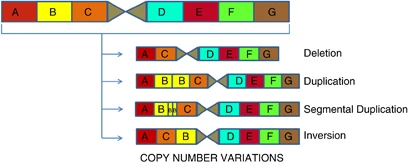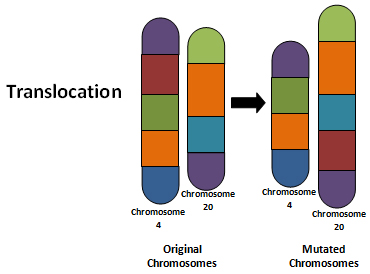1.7 Types of mutations - Oronda/Molecular_biology_concepts GitHub Wiki
Mutations can be classified on the basis of structural change or their functional effect.
Mutations based on structural change
The change occurs in the gene. They include;
A. Point mutation/Substitution
It is where there is a change in one base/s in DNA sequence.
Substitution of a purine for the purine of a pyrimidine for a pyrimidine is called transition.
Substitution of a purine for a pyrimidine and vice versa is called transversion.
Point mutations that have no impact on the organisms are called silent mutations.
A missense mutation is when the substitution results in the in a codon for a different amino acid.
A nonsense mutation occurs when the substitution results in a formation of a stop codon.

B. Inversion
Happens when a segment of a chromososme is reversed end to end.

C.Insertions
When a base(s) is added to a to the sequence.
Frame-shift mutations occur where only a nucleotide is added and they shift the reading frame of the codon.

D.Deletions
Occur when a base(s) is deleted from the sequence.
Deletions can also cause frame-shift mutations.

E.Copy number variation
Is a type of mutation where large chunks of DNA are inserted, repeated or lost. The regions can be 10,000 to 5,000,000 bases long.

F.Addition of an extra copy of a chromosome. This causes Downs' Syndrome.
G.Translocation
It happens where a piece of DNA from one chromosome may get moved to another chromosome or to another region of the same chromososme.

Mutations based on the functional effect
A.Loss of function
Is a mutation which results in reduced activity or quantity of the normal product. Most mutations other than missense mutations result in a loss-of-function effect. Loss-of-function mutations can be associated with either dominant or recessive inheritance. Most inborn errors of metabolism are caused by loss-of-function mutations which are harmless in the heterozygous (carrier) state, indicating that 50% of normal enzyme activity is usually sufficient for normal function.
B.Gain of function
It is a mutation which results in increased activity or quantity of the gene product. These are less common than loss-of-function mutations. Example is the Huntington disease.
C.Dominant negative effect
A mutation has a dominant negative effect if the product of the mutant allele interferes with the product of another normal allele, resulting in an overall adverse outcome. Dominant negative effects usually arise when the protein product has multiple components, enabling the mutant protein to disrupt the function of the final product.